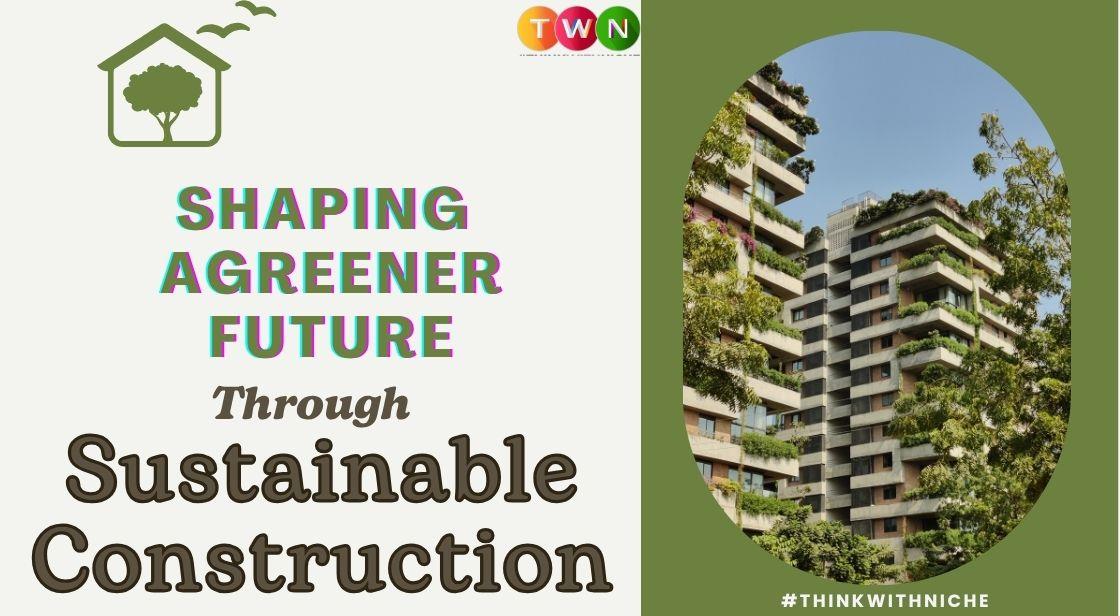Shaping a Greener Future Through Sustainable Construction

Blog Post
One of the most persistent myths surrounding sustainable construction is that it comes with a hefty price tag—making it an option only for high-budget projects or luxury developments.
However, this belief is increasingly being challenged by real-world data and successful case studies. Green buildings, when planned and executed strategically, are not just environmentally responsible—they are financially smarter and economically viable in the long run.
From significantly lower energy and water bills to reduced maintenance costs and higher property value, the long-term return on investment (ROI) for sustainable construction is often far greater than that of conventional buildings.
Moreover, as regulatory incentives and market demand for green-certified spaces grow, developers and investors are finding that sustainability pays—not just ethically, but financially.
In this section, we explore how smart design choices, cutting-edge technologies, and shifting market dynamics are transforming sustainable construction into a cost-effective solution for future-ready infrastructure.
How Sustainable Construction Is Transforming the Industry
India’s construction industry is undergoing a dynamic shift. No longer confined to traditional methods or merely chasing green certifications, the industry is being reimagined through cutting-edge technologies, policy support, and a deeper commitment to environmental responsibility. As the sector evolves, there is a growing realisation that sustainable construction must extend beyond symbolic achievements and instead focus on practical, long-lasting impacts.
Below, we break down the new definition of sustainable construction, why it matters, and what it means for India's built environment.
Beyond Greenwashing: The Need for a Comprehensive Strategy
Green Certifications Are Just the Beginning
Green certifications such as LEED, GRIHA and IGBC have undoubtedly played a crucial role in creating awareness and pushing developers toward eco-friendly practices. However, certifications alone cannot ensure that a building will be environmentally friendly throughout its lifecycle. The overemphasis on certifications can sometimes lead to greenwashing—where the label of sustainability is used more for branding than for impact.
A Shift Toward Real-World Performance
The future of construction lies in how a building performs over time—not how it was marketed at the time of completion. Key factors like energy usage, indoor air quality, thermal comfort, maintenance costs, and the building’s ability to adapt to future environmental challenges will determine its true sustainability.
Integrating Environmental Resilience
Buildings of the future need to withstand extreme weather events, rising temperatures, and water scarcity. This requires materials and design practices that go beyond aesthetics and compliance to embrace environmental resilience as a core value.
Alao Read: Strategies for Developing a Sustainable Business Growth Plan
Harmonising Architecture with Nature
Modern sustainable construction is increasingly moving away from artificial, resource-intensive designs and returning to the basics—integrating buildings with their natural surroundings. This approach doesn’t just benefit the planet; it also enhances occupant comfort, health, and productivity.
Designing for the Local Environment
Contextual design is a cornerstone of sustainable architecture. This involves creating structures that respond thoughtfully to the local climate, culture, and topography. For example:
-
In hot and humid regions, buildings can be oriented to maximize cross-ventilation, reducing dependence on air conditioning.
-
In areas with heavy rainfall, rainwater harvesting systems can be built into rooftops and landscapes to reduce water runoff and promote reuse.
-
Using locally sourced materials such as stone, bamboo, or mud not only reduces the carbon footprint associated with transportation but also enhances thermal comfort by aligning with regional conditions.
Such responsive architecture ensures that buildings remain energy-efficient while embracing the identity of their surroundings.
Biophilic Design: Reconnecting Occupants with Nature
Biophilic design takes this a step further by bringing nature indoors. Projects like Titan’s Integrity Campus in Bengaluru exemplify this, with:
-
Open-air structures
-
Abundant greenery integrated into workspaces
-
Natural ventilation and daylighting
These design choices don’t just reduce operational costs—they actively improve mental well-being, increase productivity, and create healthier environments. By fostering a constant connection with the natural world, biophilic design transforms buildings into living, breathing ecosystems that nurture both people and planet.
Leveraging Advanced Technologies for Sustainable Development
The Rise of Building Information Modelling (BIM)
BIM is more than just a digital tool—it represents a paradigm shift in how we approach building design and lifecycle management. By creating intelligent 3D models, BIM enables stakeholders to visualise, simulate, and optimise the performance of buildings before construction even begins.
How BIM Enhances Sustainability
-
Material optimisation: Reduces construction waste through precise planning.
-
Energy modelling: Simulates HVAC performance, lighting, and insulation requirements.
-
Water efficiency planning: Integrates rainwater harvesting and greywater recycling from the design stage.
-
Lifecycle analysis: Enables assessment of energy and resource use over a building’s lifetime.
AI and IoT: The Smart Backbone of Green Buildings
Artificial Intelligence and the Internet of Things (IoT) are now being integrated into BIM platforms to further enhance efficiency:
-
AI-powered design: Suggests the most sustainable materials, layouts, and energy solutions.
-
IoT sensors: Monitor real-time usage of energy and water, adjusting systems automatically to reduce waste.
-
Predictive maintenance: Prevents system breakdowns by alerting maintenance teams before inefficiencies arise.
-
Digital twins: Provide real-time replicas of physical structures for ongoing performance monitoring.
Case in Point: Smart Energy Systems
Buildings like the Palazzo Tower in Las Vegas and the Reforma Tower in Mexico City have implemented real-time energy control systems and automation tools. These ensure minimal energy consumption while maintaining occupant comfort, setting new benchmarks in smart green construction.
Cost-Effectiveness: Debunking the Myth of “Expensive Sustainability”
A common misconception surrounding sustainable construction is that it is prohibitively expensive. While green buildings may involve a higher upfront investment, the long-term benefits far outweigh the initial costs. Sustainability, when done right, is not a financial burden—it’s a smart economic strategy.
Long-Term Economic Gains
Numerous global studies and industry reports confirm that green buildings significantly reduce operational costs over their lifecycle.
-
Lower utility bills through energy-efficient systems reduce monthly overheads.
-
Improved insulation and natural lighting cut down on heating, cooling, and electricity use.
-
Reduced maintenance and repair costs thanks to the use of durable, high-quality materials.
-
Boosted employee well-being in commercial spaces leads to better productivity and reduced absenteeism.
Over a 20–30 year building lifespan, these savings can add up to millions in reduced expenses.
Financial Benefits of Smart Design
Smart design solutions—like intelligent HVAC systems, LED lighting, greywater recycling, and passive solar orientation—not only lower energy consumption but also reduce reliance on costly mechanical infrastructure.
-
Fewer breakdowns and replacements mean lower capital expenditure in the long run.
-
Integrated automation helps monitor and optimise usage, further improving cost efficiency.
Attracting Conscious Tenants and ESG-Focused Investors
Today’s real estate market is shifting. Tenants and investors are actively seeking green-certified buildings that align with their values and ESG commitments.
-
This demand results in higher occupancy rates, better lease terms, and premium property valuations.
-
Institutional investors are also more likely to back sustainable developments, recognising their resilience and long-term profitability.
In essence, sustainability is no longer a luxury—it’s a lucrative investment.
Policy Push: Government as a Catalyst for Green Transformation
India’s Progressive Policy Framework
India’s Green Building Policy, introduced in 2006, has laid the groundwork for sustainable urban infrastructure. By setting clear targets and integrating green norms into building codes, the government is institutionalising sustainability at the national and state levels.
Incentives Driving Adoption
To accelerate the green transition, multiple incentives are offered:
-
Floor Area Ratio (FAR) benefits for green-certified buildings.
-
Rebates on property tax, building permit fees, and development charges.
-
Income Tax benefits under Section 35AD for developers investing in solar panels, waste management, and water-saving systems.
-
Low-interest loans via IREDA for projects adopting renewable energy and sustainability technologies.
These incentives are not just encouraging—they are removing the financial friction that previously made green construction seem inaccessible to mid-sized developers.
The Role of MBBL and State Governments
The Model Building Byelaws (2016) has created a baseline framework that states can adapt to local needs. Many states like Maharashtra, Karnataka, and Tamil Nadu have already integrated these norms into their building policies, showing a strong federal commitment to sustainable construction.
India’s Emerging Leadership in Sustainable Infrastructure
Ranked Third Globally in Green Buildings
India now ranks third globally for the number of LEED-certified green buildings. This achievement highlights the country’s growing emphasis on creating sustainable infrastructure and demonstrates the viability of large-scale green adoption.
Private Sector Innovation
Companies like Infosys, Godrej, ITC, and Suzlon are at the forefront of sustainable innovation, not just building green campuses but embedding sustainability into their corporate ethos. Their success proves that environmental responsibility and business performance can go hand in hand.
Urban Sustainability and Smart Cities
Smart City initiatives across India are increasingly prioritising sustainability by:
-
Integrating renewable energy in public infrastructure
-
Mandating energy-efficient street lighting
-
Promoting electric mobility and sustainable transport corridors
-
Setting up decentralised waste treatment plants
These urban transformations show how sustainability is moving from isolated buildings to full ecosystems.
Education and Awareness: Empowering the Workforce
Upskilling Construction Professionals
Sustainable construction requires new skill sets. Architects, civil engineers, planners, and contractors must be equipped with knowledge of green building techniques, BIM tools, and environmental regulations.
Government agencies and private institutions are now offering certification programs, online training modules, and workshops focused on:
-
Energy-efficient design
-
Green building materials
-
Construction waste management
-
Carbon accounting and reporting
Creating a Green Mindset
Promoting sustainability isn’t just about regulations and technology. A culture shift is required where sustainability is seen as integral to business, not a CSR activity. Educational institutions, professional associations, and industry leaders must work together to embed this mindset across the value chain.
Conclusion: The Future is Already Here
Sustainable construction is no longer a concept of the future—it is a present-day imperative. As India continues its rapid urbanisation, the construction sector must prioritise long-term environmental harmony, occupant well-being, and economic efficiency over temporary compliance and marketing optics.
The true measure of sustainability will lie in how well our buildings:
-
Use resources efficiently
-
Enhance quality of life
-
Reduce emissions over decades
-
Adapt to evolving climatic challenges
With a powerful combination of technology, policy, and people, India has the opportunity to lead the global movement in sustainable construction. The challenge now is not whether to adopt green practices—but how to make them the standard, scalable, and sustainable for generations to come.
You May Like
EDITOR’S CHOICE












